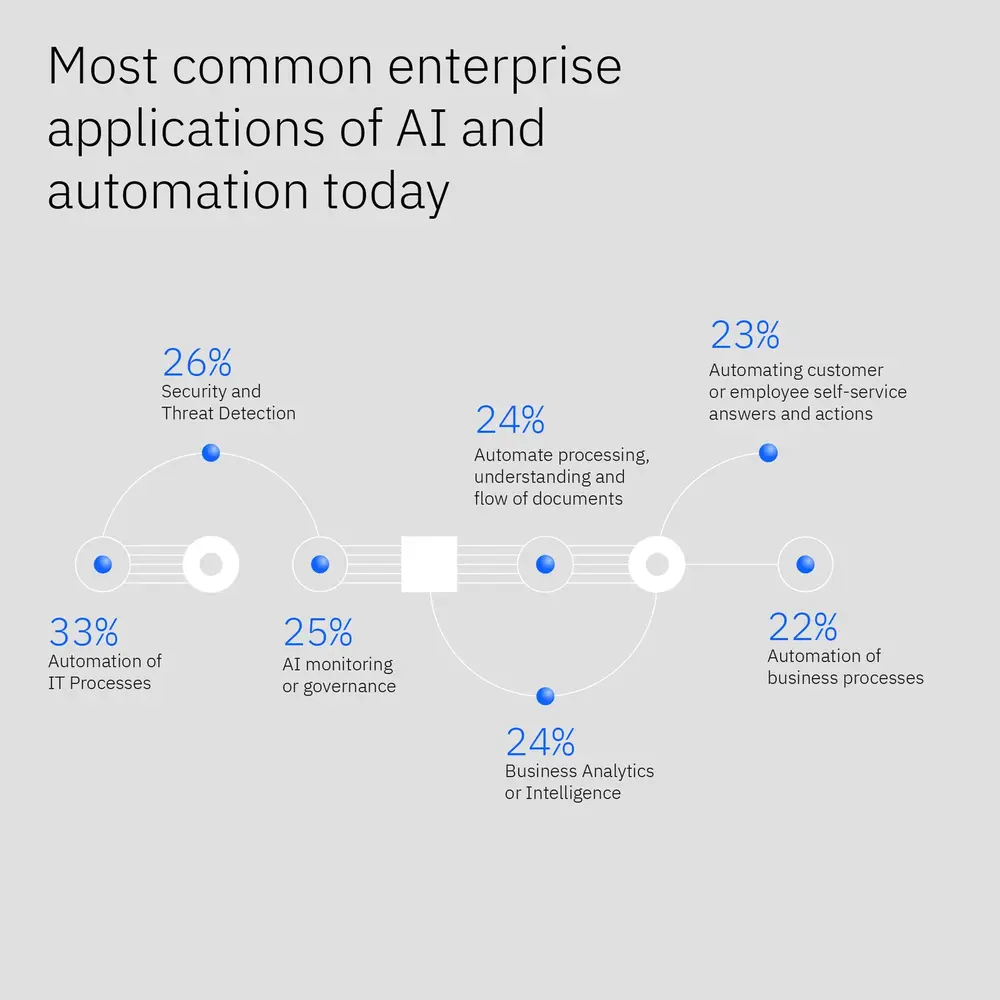Artificial Intelligence seems to be everywhere, and its penetration into the workforce is becoming increasingly evident. According to the latest IBM Global AI Adoption Index 2023, which surveyed 8,584 IT professionals worldwide, AI adoption has remained steady at large organizations.
Today, 42% of IT professionals report that they have actively deployed AI, while an additional 40% are actively exploring the use of the technology. Companies in countries such as India, the UAE region, Singapore, and China are leading the way in active AI use compared to the USA, Latin America, and Europe.
On the other hand, it is also worth noting that most organizations mentioned in the study that the incorporation of AI into their operations faces barriers, with the main concerns surrounding its adoption being limited AI skills and expertise (33%), too much data complexity (25%), and ethical concerns (23%).
This panorama makes it clear that AI is much more than a trend, its implementation and use in the corporate world, regardless of the industry, will continue to grow, forcing organizations to create a strategy for its adoption in the near future.
In this article, we will explore a step-by-step guide for your business to begin establishing a plan for the use of AI within its operations, as well as the ethical side of its implementation.
A Step-by-Step Guide to Integrating AI into Your Workflow

1. Define Your Objectives:
Whether it's improving customer service, optimizing operations, or enhancing decision-making, having a clear understanding of your goals will guide the selection and development of AI solutions tailored to your business needs.
2. Assess Your Data:
Conduct a comprehensive assessment of your existing data sources, including internal databases, customer interactions, and external datasets. Identify gaps, inconsistencies, and data quality issues that may impact the performance of AI algorithms and take steps to address them, such as data cleansing, normalization, and augmentation.
3. Choose the Right AI Technology:
Evaluate your requirements, budget, and technical expertise to determine the most suitable AI tools and platforms for your business. Consider factors such as scalability, ease of integration, and vendor support when making your decision.
4. Start Small and Iterate:
Begin with pilot projects or proof-of-concepts to test the feasibility and effectiveness of AI solutions in real-world scenarios. This iterative approach allows you to validate assumptions, gather feedback, and refine your AI models iteratively, ensuring incremental improvements and mitigating risks along the way.
5. Integrate AI into Your Workflow:
Work closely with stakeholders, including IT, data science, and business units, to design integration points and workflows that leverage AI capabilities effectively. Provide training and support to employees to ensure they understand how to interact with AI systems.
6. Monitor Performance and Iterate:
Establish key performance indicators (KPIs) and metrics to measure the impact of AI on business outcomes, such as productivity gains, cost savings, and customer satisfaction. Regularly review and analyze performance data.
7. Stay Agile and Adaptive:
To stay ahead of the curve, cultivate a culture of agility and adaptability within your organization. Embrace experimentation and continuous learning, encouraging employees to explore new ideas and experiment with cutting-edge AI technologies to drive ongoing innovation and transformation.
The Importance of the Human Touch in AI Implementation

While AI technologies offer immense potential for efficiency, productivity, and innovation, it's crucial to remember that these tools are designed and deployed by humans, for humans.
This means prioritizing user experience, empathy, and accessibility throughout the development and deployment process. By focusing on human-centered design principles, businesses can create and incorporate AI-powered systems that are intuitive, user-friendly, and genuinely helpful for their customers and employees. Additionally, ethical considerations play a crucial role in AI implementation, as these technologies have the power to impact individuals, communities, and societies at large
This includes ensuring that AI algorithms are unbiased and free from discrimination, respecting user privacy rights, and being transparent about how AI technologies are used and the potential implications for individuals and society.
Businesses must also stay abreast of the latest advancements in emerging software solutions that complement AI capabilities. By integrating emerging software into AI systems, companies can enhance their functionality, improve decision-making processes, and unlock new possibilities for growth and innovation.
Explore Jalasoft Innovation Hub
At Jalasoft, we are not only committed to innovation but also to responsible AI implementation. By integrating emerging technologies, we enhance the value we provide to our clients while maintaining robust security practices.
As part of our R&D efforts, we recently launched an exciting update to Cosmic Latte, our all-in-one platform for internal data collection flows. This new version, integrated with Open AI, enables rapid, personalized workplan generation for 360 evaluations using an LLMS (Large Language Model Service) based on Open AI 3.5 and Open AI 4.0.
If you want to explore the innovative engineering developments created by our RD team or learn more details about our nearshore engineering services, contact us.
